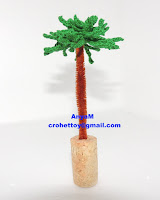Christmas gifts - Palm trees.
Green 100% cotton yarn, hook 1.65mm/6, brown chenille stems & wine cork.
Size approximately 4in tall.
Пальмы сделаны на подарок. Зеленая пряжаб кр. 1.65мм, коричневая пушистая проволовка и
пробка из под вина. Размер примерно 10см.
The quintessential image of a tropical paradise, the
palm tree is much more significant than you might think. At the sight of a palm tree, most people imagine a sunny beach setting — but these sturdy plants can also grow in a variety of other environments. Here are 10 things you may not have known about these tropical beauties:
1. There are over 2,500 species of palm trees. The Arecaceae family of plants includes wonderfully diverse species found throughout the world, from the
desert to the rainforest.

2. Not all palm trees are "trees," and not all plants called "palms" are truly palms. These evergreen plants can grow in the form of shrubs, trees or long, woody vines called lianas. Plants like the yucca palm, Torbay palm (pictured right), sago palm and traveler's palm are not part of the Arecaceae family.
3. Palm trees have two different types of leaves: palmate and pinnate. Palmate leaves, like hands, grow in a bunch at the end of a stem. Pinnate leaves are like feathers, growing all along either side of a stem.
4. Palm trees are important religious symbols. In the Bible, the people of Jerusalem greeted a triumphant Jesus just one week before his death and resurrection, a tradition now known and celebrated as Palm Sunday the week before
Easter. Palms are mentioned dozens of times in both the Bible and the Quran. In Judaism, palms represent peace and plenty.
5. Lots of staples come from palm trees. Coconuts are an obvious product of palm trees, but did you know that dates, betel nuts and acai fruit all come from palm trees as well? Palm oil, as its name indicates, also comes from the fruit of the oil palm tree.
6. Palms grow best in USDA Zones 8-10. You don't have to live in Florida or California to use large palm trees in your landscaping. Check out this handy guide to discerning the USDA's planting zone map to find out if the plants would be viable where you live.





 2. Not all palm trees are "trees," and not all plants called "palms" are truly palms. These evergreen plants can grow in the form of shrubs, trees or long, woody vines called lianas. Plants like the yucca palm, Torbay palm (pictured right), sago palm and traveler's palm are not part of the Arecaceae family.
2. Not all palm trees are "trees," and not all plants called "palms" are truly palms. These evergreen plants can grow in the form of shrubs, trees or long, woody vines called lianas. Plants like the yucca palm, Torbay palm (pictured right), sago palm and traveler's palm are not part of the Arecaceae family. 







































